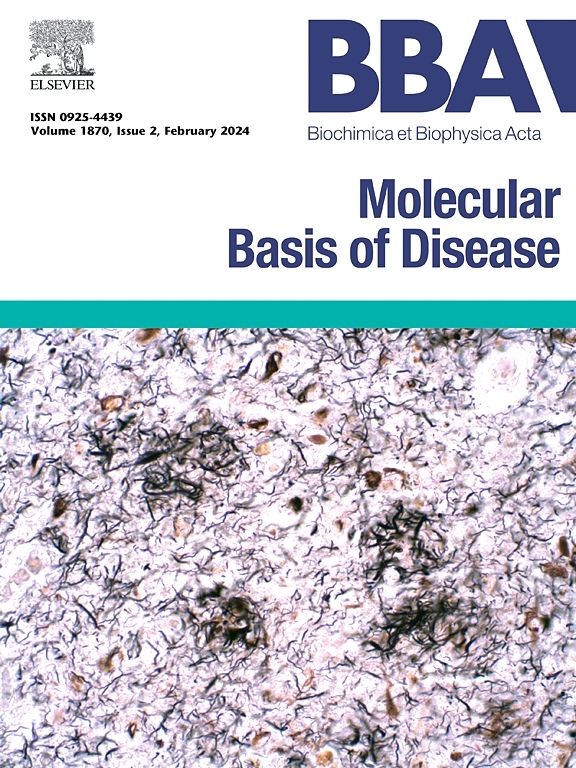IGF2BP1 exacerbates neuroinflammation and cerebral ischemia/reperfusion injury by regulating neuronal ferroptosis and microglial polarization
IF 4.2
2区 生物学
Q2 BIOCHEMISTRY & MOLECULAR BIOLOGY
Biochimica et biophysica acta. Molecular basis of disease
Pub Date : 2025-04-26
DOI:10.1016/j.bbadis.2025.167877
引用次数: 0
Abstract
Background
Cerebral ischemia/reperfusion (I/R) injury induces neuronal ferroptosis and microglial phenotypic shifts, driving post-ischemic neurological deficits. This study examines the regulatory role of the N6-methyladenosine (m6A) reader insulin-like growth factor 2 mRNA-binding protein 1 (IGF2BP1) in coordinating these pathological processes through Keap1/Nrf2 signaling.
Methods
Cerebral I/R injury was modeled in C57BL/6 mice via middle cerebral artery occlusion (MCAO) and in hippocampal neurons and microglia through oxygen-glucose deprivation/reperfusion (OGD/R). Pro-inflammatory microglial polarization was induced by LPS/IFN-γ stimulation. IGF2BP1's functional impacts were assessed through knockdown and overexpression approaches, with mechanistic evaluations focusing on ferroptosis biomarkers, microglial polarization states, and Keap1/Nrf2 pathway activity. A microglia-neuron co-culture system elucidated cellular crosstalk mechanisms.
Results
MCAO-operated mice demonstrated upregulated IGF2BP1 expression accompanied by neuronal apoptosis and microglial M1 polarization. IGF2BP1 silencing significantly attenuated OGD/R-induced neuronal ferroptosis, evidenced by reduced iron overload (Fe2+), lipid peroxidation (MDA), and reactive oxygen species (ROS) alongside restored glutathione (GSH) levels, while concurrently enhancing GPX4 activity through Keap1/Nrf2 pathway regulation. This intervention further shifted microglial polarization toward the M2 phenotype, effectively mitigating neuroinflammatory responses. Importantly, the neuroprotective effects of IGF2BP1 knockdown were abolished upon Keap1 overexpression. Co-culture experiments revealed that IGF2BP1-depleted microglia suppressed neuronal ferroptosis via phenotypic reprogramming. In vivo validation confirmed that IGF2BP1 knockdown ameliorated neurological deficits and reduced ferroptosis markers in MCAO-challenged mice.
Conclusion
IGF2BP1 serves as a critical regulator of cerebral I/R injury by exacerbating neuronal ferroptosis and sustaining detrimental microglial activation. These findings nominate IGF2BP1 inhibition as a promising strategy for ischemic stroke intervention.

IGF2BP1通过调节神经元铁上落和小胶质细胞极化,加重神经炎症和脑缺血再灌注损伤
脑缺血/再灌注(I/R)损伤导致神经元铁下垂和小胶质细胞表型改变,导致缺血后神经功能缺损。本研究探讨了n6 -甲基腺苷(m6A)阅读器胰岛素样生长因子2 mrna结合蛋白1 (IGF2BP1)在通过Keap1/Nrf2信号通路协调这些病理过程中的调节作用。方法采用大脑中动脉闭塞法(MCAO)建立C57BL/6小鼠脑I/R损伤模型,采用氧糖剥夺/再灌注法(OGD/R)建立海马神经元和小胶质细胞脑I/R损伤模型。LPS/IFN-γ刺激可诱导炎性小胶质细胞极化。通过敲低和过表达的方法评估IGF2BP1的功能影响,机制评估侧重于铁ptosis生物标志物、小胶质细胞极化状态和Keap1/Nrf2通路活性。小胶质细胞-神经元共培养系统阐明了细胞串扰机制。结果smcao操作小鼠IGF2BP1表达上调,伴有神经元凋亡和小胶质细胞M1极化。IGF2BP1的沉默显著减轻了OGD/ r诱导的神经元铁凋亡,这可以通过降低铁过载(Fe2+)、脂质过氧化(MDA)和活性氧(ROS)以及恢复谷胱甘肽(GSH)水平来证明,同时通过Keap1/Nrf2通路调节增强GPX4活性。这种干预进一步将小胶质细胞极化向M2表型转移,有效地减轻了神经炎症反应。重要的是,IGF2BP1敲低的神经保护作用在Keap1过表达时被消除。共培养实验显示,igf2bp1缺失的小胶质细胞通过表型重编程抑制了神经元铁凋亡。体内验证证实,IGF2BP1敲低可改善mcao挑战小鼠的神经功能缺损并降低铁吊标志物。结论igf2bp1在脑I/R损伤中起关键调节作用,其机制是通过加重神经元铁下沉和维持有害的小胶质细胞激活。这些发现表明抑制IGF2BP1是一种有希望的缺血性卒中干预策略。
本文章由计算机程序翻译,如有差异,请以英文原文为准。
求助全文
约1分钟内获得全文
求助全文
来源期刊
CiteScore
12.30
自引率
0.00%
发文量
218
审稿时长
32 days
期刊介绍:
BBA Molecular Basis of Disease addresses the biochemistry and molecular genetics of disease processes and models of human disease. This journal covers aspects of aging, cancer, metabolic-, neurological-, and immunological-based disease. Manuscripts focused on using animal models to elucidate biochemical and mechanistic insight in each of these conditions, are particularly encouraged. Manuscripts should emphasize the underlying mechanisms of disease pathways and provide novel contributions to the understanding and/or treatment of these disorders. Highly descriptive and method development submissions may be declined without full review. The submission of uninvited reviews to BBA - Molecular Basis of Disease is strongly discouraged, and any such uninvited review should be accompanied by a coverletter outlining the compelling reasons why the review should be considered.

 求助内容:
求助内容: 应助结果提醒方式:
应助结果提醒方式:


